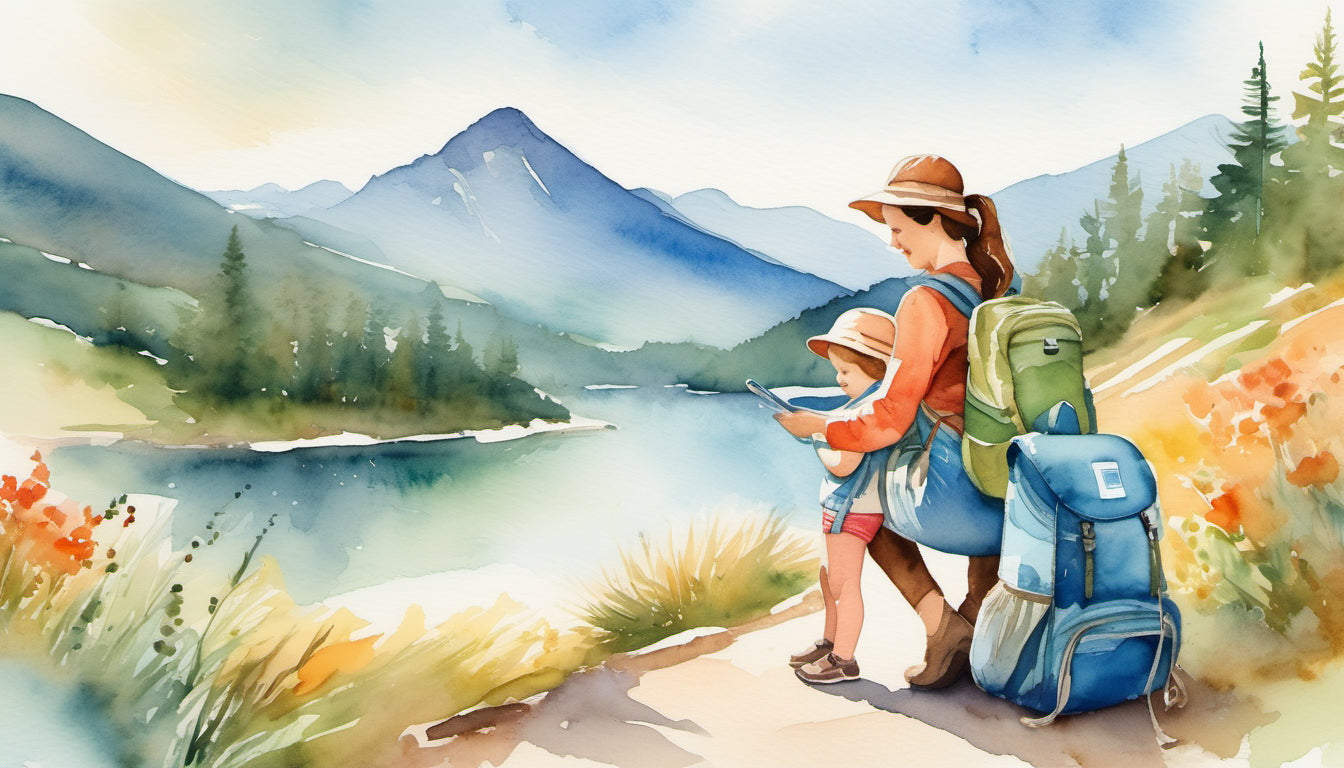Hey there, stay-at-home moms! Are you ready to step out of the house and enjoy some quality time with your little ones in the great outdoors? Outdoor activities not only provide a breath of fresh air but also offer a wide range of benefits for both you and your children. However, it's important to prioritize safety while exploring the wonders of nature.
In this article, we will discuss some essential outdoor safety tips that every stay-at-home mom should know. From planning outdoor activities to childproofing your surroundings and ensuring personal safety, we've got you covered. So, grab a cup of coffee, sit back, and let's dive into these must-know security measures for a memorable and worry-free experience in nature.
Importance of Outdoor Safety for Stay-at-Home Moms
As a stay-at-home mom, outdoor safety is a crucial aspect to consider when planning activities for you and your children. Spending time outdoors provides numerous benefits, both for your physical and mental well-being. It is important to ensure that you and your family stay safe while enjoying the great outdoors. Here are a few reasons why outdoor safety should be a top priority for stay-at-home moms:
Promoting Physical and Mental Well-being
Spending time outdoors allows you and your children to engage in physical activities such as walking, hiking, or playing sports. These activities not only keep you physically active but also help improve your cardiovascular health, strengthen muscles, and increase flexibility. Moreover, exposure to natural sunlight boosts vitamin D levels, which is essential for bone health and overall well-being.
Outdoor activities also have a positive impact on mental health. Being in nature helps reduce stress, anxiety, and depression, and promotes feelings of calmness and relaxation. It provides an opportunity to escape the daily routine and enjoy the beauty of nature, which has been shown to have a therapeutic effect on the mind.
Encouraging Quality Family Time
Outdoor activities provide an excellent opportunity for you and your family to bond and create lasting memories. Whether it's a picnic in the park, a hiking adventure, or simply spending time in the backyard, engaging in activities together helps strengthen family relationships. It allows you to disconnect from screens and distractions, and focus on each other's company.
Teaching Children About Nature and Responsibility
Exposing your children to the outdoors from an early age helps them develop a deep appreciation for nature and the environment. It also teaches them about responsibility and safety. By following proper outdoor safety guidelines, you can instill in your children valuable skills such as understanding their surroundings, identifying potential risks, and taking precautions to stay safe.
Being knowledgeable about outdoor safety not only ensures the well-being of your family but also empowers you to make informed decisions and take necessary precautions. Let's explore some essential tips for planning outdoor activities and ensuring personal safety in the next sections.
Planning Outdoor Activities
When it comes to planning outdoor activities for you and your children, there are several factors to consider to ensure a safe and enjoyable experience. Here are some important tips to help you plan your outdoor adventures:
Choosing Suitable Locations
- Look for parks, playgrounds, or nature reserves in your area that are family-friendly and suitable for children of different ages.
- Consider the facilities available at the location, such as restrooms, shaded areas, and picnic spots.
- Check if the location has designated areas for different activities, such as hiking trails, biking paths, or fishing spots.
Researching Weather Conditions
- Before heading out, check the weather forecast to ensure you're prepared for any changes in weather during your outing.
- Avoid planning activities on days with extreme weather conditions, such as heavy rain, thunderstorms, or excessive heat.
- Pack appropriate clothing and gear based on the expected weather, such as raincoats, hats, or sunscreen.
Informing Others About Your Plans
- Always inform a trusted friend or family member about your outdoor plans, including the location, expected duration, and contact information.
- Share your itinerary with someone who can check in on you if needed.
- If you're going on a more remote adventure or a longer hike, consider using a tracking app or device that allows others to monitor your location.
By taking these steps to plan your outdoor activities, you can ensure a smoother and safer experience for you and your family. Whether it's a picnic in the park, a day at the beach, or a hike in the mountains, proper planning will help you make the most of your time outdoors while keeping everyone safe.
Remember: Safety should always be a priority when planning outdoor activities. It's essential to choose locations that are suitable for your family, research weather conditions, and inform others about your plans. By being prepared, you can enjoy a fun-filled day outside with your loved ones.
Ensuring Personal Safety
As a stay-at-home mom, ensuring your personal safety is crucial when engaging in outdoor activities with your children. By taking the necessary precautions, you can enjoy the great outdoors while minimizing the risk of accidents or injuries. Here are some essential tips to keep in mind:
Dressing Appropriately for Outdoor Activities
- Wear comfortable and appropriate clothing for the activity you are planning. Consider the weather conditions and dress in layers to adjust to temperature changes.
- Opt for sturdy footwear that provides good traction to prevent slips and falls.
- Don't forget to wear a hat and sunglasses to protect yourself from the sun's harmful rays.
Using Sunscreen and Insect Repellent
- Apply sunscreen with a high SPF before heading outdoors, even on cloudy days. Reapply every two hours or more frequently if you're sweating or swimming.
- Protect yourself and your children from annoying bug bites by using insect repellent. Look for products that contain DEET or other effective ingredients recommended by health authorities.
Carrying First Aid and Emergency Supplies
- Pack a well-stocked first aid kit that includes essentials such as bandages, antiseptic wipes, tweezers, and adhesive tape.
- Carry a fully charged cell phone or a two-way radio for communication purposes in case of emergencies.
- It's also a good idea to bring along a whistle or a loud noise device to attract attention if needed.
Taking these personal safety measures will help ensure a smooth and worry-free experience while enjoying outdoor activities with your children. Remember, being prepared is the key to preventing accidents and dealing with unexpected situations.
Childproofing Outdoor Spaces
When it comes to outdoor safety for stay-at-home moms, one of the most important aspects is childproofing the outdoor spaces where your kids will be playing. By taking some simple precautions, you can create a safe and secure environment for your children to enjoy the outdoors. Here are some must-know tips for childproofing outdoor spaces:
Securing Fences and Gates
- Inspect your fences and gates: Regularly check your fences and gates for any damages or gaps. Make sure they are sturdy and in good condition.
- Install childproof locks: If your fence has a gate, consider installing childproof locks to prevent your little ones from wandering outside unsupervised.
- Cover any gaps: If there are any gaps in the fence, cover them with mesh or other materials to prevent your child from squeezing through.
Removing Hazards and Potential Dangers
- Clear the area: Remove any sharp objects, tools, or debris from the outdoor space. Make sure that the area is clean and free from potential hazards.
- Secure loose items: Ensure that any movable objects, such as furniture or gardening tools, are properly secured so they cannot easily tip over or cause injuries.
- Check for poisonous plants: Identify and remove any poisonous plants from your outdoor space. Keep in mind that some common plants can be toxic to children if ingested.
Supervising Children at All Times
- Never leave children unattended: Always keep a close eye on your children when they are playing outdoors. Never leave them unattended, even for a short period of time.
- Be within reach: Stay within arm's reach of your child, especially around water or in potentially dangerous areas.
- Teach outdoor safety rules: Instruct your children about outdoor safety rules, such as not running near stairs or avoiding climbing on unstable structures.
By implementing these childproofing measures, you can create a safe outdoor space where your children can play and explore without unnecessary risks. Remember, outdoor safety is all about being proactive and taking the necessary steps to prevent accidents before they happen.
"Childproofing outdoor spaces is essential for creating a safe and secure environment for your children to enjoy the outdoors."
Water Safety Tips
When it comes to outdoor activities, water can provide hours of fun and relaxation for stay-at-home moms and their families. Whether you're planning a trip to the beach, a pool day, or spending time at a local lake, it's crucial to prioritize water safety. Here are some essential tips to ensure a safe and enjoyable experience:
1. Supervising Children Near Water
- Constant supervision: Always keep a watchful eye on your children when they are near water. Accidents can happen in an instant, so it's crucial to be attentive.
- Designated Water Watcher: Assign an adult as the "water watcher" whose sole responsibility is to keep an eye on the children in or near the water. This rotation system ensures there is always a responsible adult present.
2. Teaching Basic Water Safety Skills
Teaching your children basic water safety skills can greatly reduce the risk of accidents. Make sure they are familiar with the following:
- Swimming lessons: Enroll your children in age-appropriate swimming lessons to equip them with important water skills and confidence in the water.
- Safety rules: Educate your children on basic water safety rules such as not running near pools or jumping into unfamiliar bodies of water without permission or supervision.
3. Using Life Jackets and Floatation Devices
Life jackets and floatation devices are vital for water activities, especially for young children who may not have strong swimming skills. Here are some pointers:
- Proper fit: Ensure that life jackets fit snugly and are appropriate for your child's size and weight.
- Approved devices: Use only U.S. Coast Guard-approved life jackets and floatation devices. Check for the approval label before purchasing or borrowing.
Remember, life jackets are a priority, not an option. Even if your child knows how to swim, it's essential to have them wear a life jacket in situations where the water can be unpredictable or there are strong currents.
Conclusion
Water activities can be a delightful way to spend time outdoors with your family. By following these water safety tips, you can ensure that the fun remains enjoyable and, most importantly, safe for everyone involved.
Remember, supervision, education, and proper safety equipment are the keys to a successful day by the water. So, dive in and make memories while prioritizing safety!
Awareness of Wildlife and Nature
When it comes to outdoor safety for stay-at-home moms, being aware of wildlife and nature is crucial. By educating yourself about the local wildlife and understanding how to prevent encounters with dangerous animals, you can ensure the safety of yourself and your children. Additionally, it is important to have a deep respect for the natural environment and teach your children the same.
Here are some tips to help you navigate the world of wildlife and nature with confidence:
Educate Yourself About Local Wildlife
Take the time to research and learn about the wildlife that is common in your area. This knowledge will help you identify potential risks and understand how to respond in certain situations. Knowing which animals are harmless, which are dangerous, and what to do if you encounter them is essential. Local wildlife authorities or online resources can provide valuable information on the wildlife in your region.
Prevent Encounters with Dangerous Animals
While it's unlikely that you will come face-to-face with a dangerous animal, it's always smart to be prepared. Here are some ways to prevent encounters:
- Keep food and garbage securely stored to avoid attracting wildlife.
- Be cautious near bushes, tall grass, and other hiding spots for animals.
- Make noise when hiking or walking to alert animals to your presence.
- Keep your distance if you do spot wildlife and never approach or feed them.
- If you encounter a potentially dangerous animal, back away slowly without turning your back on it.
Respect the Natural Environment
Teaching your children to respect the natural environment is not only important for their safety, but also for the preservation of our ecosystem. Instill the following values in your children when spending time in nature:
- Leave no trace: Teach them to pick up after themselves and not to disturb plants, rocks, or animals.
- Stay on the trail: Help them understand the importance of sticking to designated paths to avoid damaging vegetation and disturbing wildlife habitats.
- Use designated camping areas and fire pits: Discourage setting up camp in unauthorized areas to minimize the impact on the environment.
- Teach them to appreciate nature: Encourage them to observe and appreciate the beauty of the natural world, fostering a love and understanding for wildlife and their habitats.
By being knowledgeable, proactive, and respectful, you can enjoy the great outdoors without compromising your safety or the well-being of the wildlife and nature around you. Embrace the opportunity to teach your children about the wonders of nature, instilling a sense of responsibility and appreciation for the environment that will last a lifetime.
Hiking and Walking Safety
Hiking and walking are great outdoor activities that stay-at-home moms can enjoy, providing an opportunity to exercise, connect with nature, and create lasting memories with their children. However, it's important to prioritize safety while embarking on these adventures. Here are some essential tips for hiking and walking safety:
Choosing Appropriate Trails
- Start with easy and well-marked trails, especially if you are new to hiking or have young children. Gradually progress to more challenging trails as you gain experience.
- Research the difficulty level, distance, and terrain of the trail before heading out. This will help you determine if it's suitable for your fitness level and the age of your children.
- Consider the length of the trail and choose one that fits within your available time and energy.
- Take note of the elevation gain and loss along the trail, as steep ascents and descents may pose additional challenges.
Informing Others About Your Hiking Plans
- Before hitting the trail, inform a family member or friend about your hiking plans. Share details such as the trail name, starting point, expected duration, and return time.
- Provide them with your contact information and any emergency numbers they can reach in case you don't return on time.
- If possible, use a hiking app or a tracking device to share your real-time location with someone you trust. This can be especially helpful when hiking in remote areas without cell phone coverage.
Carrying Essential Supplies and Navigation Tools
- Always pack a backpack with essential supplies such as water, snacks, a map, a compass, a flashlight, a whistle, a multi-tool, and a fully charged mobile phone.
- Wear appropriate footwear that provides good ankle support and traction. Hiking boots or sturdy athletic shoes are recommended.
- Dress in layers to accommodate changes in temperature during your hike. Remember to bring rain gear and sunscreen as well.
- Familiarize yourself with how to use a map and compass or use a GPS device or a hiking app on your smartphone for navigation, especially if you are hiking in unfamiliar territory.
- Teach your children basic navigation skills and explain the importance of staying on the trail.
By following these tips, you can ensure a safe and enjoyable hiking or walking experience. Remember, safety should always be a priority, so take the necessary precautions and be prepared for any unexpected situations that may arise. Happy hiking!
Conclusion
Conclusion
In conclusion, outdoor safety is of paramount importance for stay-at-home moms who want to ensure the well-being of themselves and their children. By following the tips and guidelines provided in this article, you can be well-prepared for outdoor activities and create cherished memories with your family. Remember to prioritize personal safety, childproof outdoor spaces, practice water safety, be aware of wildlife, and take necessary precautions when hiking or walking.
At Empowered by Ashley, we understand the importance of personal safety, which is why we offer a range of products designed to empower individuals in any situation. Our best-selling Personal Safety Alarm is a must-have device for stay-at-home moms. This alarm is compact, easy to carry, and can serve as a deterrent to potential attackers. It will make you feel safe, reassured, and secure during your outdoor adventures.
Visit our website here to explore our products and empower yourself with the tools you need to stay safe and protected. Remember, outdoor safety is an ongoing practice, so stay informed, stay prepared, and enjoy the great outdoors with peace of mind.
Frequently Asked Questions
-
What are the essential outdoor safety tips for stay-at-home moms?
Some essential outdoor safety tips for stay-at-home moms are: 1. Always supervise your children, 2. Teach them about stranger danger, 3. Ensure they wear appropriate protective gear, 4. Stay alert of their surroundings, and 5. Teach them road safety rules.
-
What are the benefits of teaching road safety rules to children?
Teaching road safety rules to children helps them understand how to safely cross the road, identify traffic signs, and be cautious of vehicles. It reduces the risk of accidents and instills responsible behavior in them as pedestrians.
-
How can stay-at-home moms ensure their children wear appropriate protective gear?
Stay-at-home moms can ensure their children wear appropriate protective gear by providing them with helmets, knee and elbow pads, and reflective clothing when engaging in activities like biking or skating. Encouraging the consistent use of safety gear sets a good example for children.
-
Why is it important to constantly supervise children while outdoors?
Constantly supervising children while outdoors ensures their safety and helps prevent accidents or incidents. It allows moms to be aware of potential risks, keep track of their children's activities, and intervene promptly if necessary.
-
What are some effective ways to teach children about stranger danger?
Some effective ways to teach children about stranger danger include role-playing scenarios, discussing safe boundaries and appropriate responses, encouraging open communication, and teaching them to trust their instincts. It's important to empower children with knowledge while maintaining a supportive and reassuring approach.
















Leave a comment
This site is protected by hCaptcha and the hCaptcha Privacy Policy and Terms of Service apply.